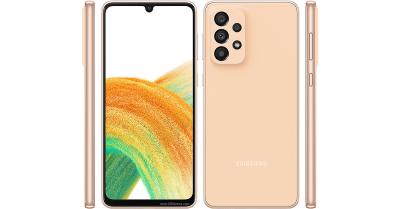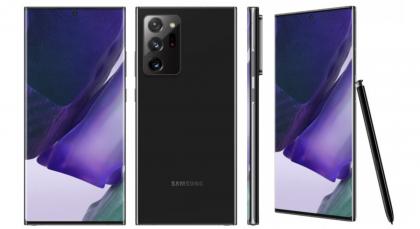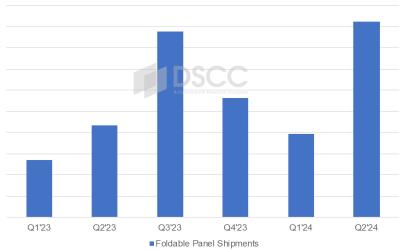Super AMOLED: introduction and market status
OLED displays use organic materials that emit light when electricity is applied. OLEDs enable emissive, bright, thin, flexible and efficient displays. OLEDs are replacing LCDs in most display applications - from smartphones and wearables to monitors and TVs.

Samsung's Super AMOLED displays, announced in 2010, are AMOLED displays for mobile devices (such as smartphones, wearables and tablets) with an integrated touch function. The thickness of the touch sensor is just 0.001 mm and this allows the screen to provide better images and to have great visibility even in direct sunlight compared with regular AMOLED displays with an external touch layer.
Samsung is producing hundreds of millions of Super AMOLED displays today, used mostly in smartphones, but also in other devices. These are considered to be some of the best displays on the market.
Super AMOLED and the Pentile matrix
Samsung's Super AMOLED displays use a Pentile matrix sub-pixel design. That means that the green sub-pixel is shared by two pixels and the display has only 2 sub-pixels per real 'pixel' compared to the classic RGB matrix design (or Real-Stripe). You can see a PenTile matrix vs a Real-Stripe one on the images below (the PenTile is on the right). Newer Super AMOLED displays use a different PenTile matrix (Diamond Pixel pattern).
Super AMOLED vs Dynamic AMOLED
In 2019 Samsung introduced its next-generation mobile display technology, which it calls Dynamic AMOLED. Basically a Dynamic AMOLED is similar to a Super AMOLED display, but it adds HDR support. Samsung's highest end smartphones adopt the company's Dynamic AMOLED 2X LTPO AMOLED displays.
Further reading
- Introduction to OLEDs
- Samsung's OLED displays
- Pentile Technology explained
- Flexible OLEDs
- OLED mobile phones
- The OLED Toolbox: a one-stop-shop for OLED information, insights, analysis and guides
DSCC sees 9.25 million foldable OLED panels shipped in Q2 2024, with Samsung returning to a dominant position
DSCC says that foldable OLED shipments increased 46% in the first quarter of 2024 compared to last year, to reach almost 4 million units.
BOE was leading the market in Q1 2024, with a market share of 48% (up from 43% in Q1 2023). The two leading foldable smartphone models were Huawei's Mate X5 and Pocket 2, using panels supplied by BOE. In fact Huawei had a market share of 55% in the foldable smartphone market.
Samsung launches a website that tells you whether your smartphone has an OLED made by SDC
Samsung Display launched a new web site, called OLED Finder, in which you can choose your phone model to see whether it uses an OLED produced by Samsung Display.
This is a marketing play by SDC, that aims to establish the superiority of Samsung's own OLED panels, over competing panels made by LGD, BOE, Visionox, etc. The website does not include all phones though that use OLED displays - for example it does not include any of Apple's iPhones.
Samsung launches three new AMOLED phones, the A33, A53 and the A73
Samsung announced three new Samsung Galaxy phones, in its popular mid-range A-series. First up is the Galaxy A33 which features a 6.4" 90Hz 1080x2400 Super AMOLED display, and the second is the Galaxy A53 which features a larger 6.5" 120Hz 1080x2400 Super AMOLED display.

Most interesting is the Galaxy A73,which sports a 6.7" 120Hz 1080x2400 Super AMOLED+. It is not clear what Samsung refers to as a Super AMOLED+, it could be a non-pentile display like the old Super AMOLED Plus displays.
Samsung sees high demand for the Galaxy Tab S8 Ulta, halts pre-orders
Last week Samsung launched its flagship tablets for 2022, the S8 series, which include two versions with AMOLED displays. It seems as if demand for the S8 (LCD) and S8 Ultra (Super AMOLED) is very high, and Samsung has halted the pre-orders for both tablets. You can still pre-order the Galaxy Tab S8+.

The Galaxy Tab S8+ sports a 12.4-inch 120Hz HDR10+ 1752x2800 Super AMOLED display. The high-end Galaxy Tab S8 Ultra offers a much larger 14.6" 1848x2960 120Hz HDR10+ Super AMOLED display. The series also includes the more basic Galaxy Tab S8 which features an LCD display (11" 1600x2560 120Hz).
Samsung launches its latest flagship phones and tablets, the Galaxy S22 series and Galaxy Tab S8 series
Samsung launched a new range of mobile devices, most of which feature AMOLED displays. The new smartphone range starts with the Galaxy S22 which sports a 6.1" 120Hz 1300 nits 1080x2340 Dynamic AMOLED 2X, and the Galaxy S22+ which offers similar specifications but with a larger 6.6" AMOLED which is also brighter at 1,750 nits.

The Galaxy S22 Ultra features a 6.8" 120Hz 1750-nits 1440x3080 Dynamic AMOLED 2X, and also stronger specifications, including up to 1TB of storage, 12GB of RAM, a quad camera setup with a main 108MP sensor and an S Pen stylus.
Samsung announces the Galaxy Fold3 and Flip3 foldable phones, and new smartwatches
Samsung announced several new OLED devices, including its two new foldable smartphones. First up is the Galaxy Z Fold3, which features a 7.6-inch 1768x2208 120Hz 1200 nits foldable Dynamic AMOLED X2 display, and a 6.2-inch 120Hz 832x2268 external AMOLED display. The foldable phone sports Samsung's first under-the-display selfie camera.

Samsung says that the new Galaxy Fold has an improved hinge design and is more durable compared to previous generation devices. The second phone is the Galaxy Flip3, which features a 6.7-inch 120Hz 1200 nits 1080x2640 foldable Dynamic AMOLED display, and an external 1.9" 260x512 Super AMOLED display.
Samsung launches several new AMOLED devices, including the Note 20 and the Galaxy Z Fold 2
Samsung announced several new OLED devices yesterday. We'll start with the new Galaxy Note 20 which sports a 6.7-inch 1080x2400 HDR10+ Super AMOLED Plus display (which could mean this is an RGB display, not a Pentile one). The Galaxy Note 20 Ultra has a larger 6.9-inch 1440x3088 Dynamic AMOLED. The display supports a refresh rate of 120Hz at Full-HD resolution and 60Hz at QHD. According to the Elec in Korea, the Note 20 Ultra display has an LTPO backplane (which Samsung calls HOP).

Next up is the company's 2nd generation Galaxy Z Fold 2 that is an update to the original fold with a larger internal foldable display at 7.6" 1768x2208 HDR10+ 120Hz Dynamic AMOLED and also a larger 6.23" 816x2260 Super AMOLED cover display. The Fold 2 also improves the hinge design and sports an ultra-thin-glass cover (like the Galaxy Z Flip).
OnePlus says its next phone to feature a 120Hz SDC AMOLED display
In May 2019 OnePlus launched the OnePlus 7 Pro - a flagship smartphone that features a large 6.67" 90Hz 1440x3120 Fluid AMOLED - a 90Hz Super AMOLED (produced by Samsung Display).

OnePlus now officially announced that its next phone (the OnePlus 8) will feature a high-end AMOLED, developed in collaboration with Samsung, that will feature a refresh rate of 120Hz, a peak brightness of 1,000 nits, 10-bit color support and a 2K+ resolution. OnePlus again brands its Super AMOLED displays as Fluid Display. The touch sample rate will be 240Hz and the phone will include a hardware MEMC smooth-video accelerator.
OnePlus launches the 7 and 7 Pro smartphones with high quality AMOLED displays
OnePlus launched it latest flagship smartphones, both of whom utilize high-end AMOLED displays. We'll start with the OnePlus 7 Pro - a flagship smartphone that features a large 6.67" 90Hz 1440x3120 Fluid AMOLED - which apparently is a 90Hz Super AMOLED. This is a full-screen display that has an under-the-display fingerprint sensor.

The OnePlus 7 has a smaller notch-type 6.41" 1080x2340 Optic AMOLED - which is again OnePlus' own display marketing term for an SDC's Super AMOLED. It seems as if OnePlus brands its regular 60Hz AMOLED displays as Optic Displays - and its higher-end 90Hz ones as Fluid AMOLEDs.
Samsung starts shipping the Super AMOLED Galaxy Tab S5e
Samsung started shipping its flagship tablet the device, the Galaxy Tab S5e - Samsung's thinnest tablet yet at 5.5 mm. The S5e features a 10.5" WQXGA (2560x1600) Super AMOLED display with a 81.8% screen-to-body ratio.
 Samsung's Tab S5e offers mid-range performance with a snapdragon 670 octa-core chipset, 4/6 GB of RA and 64/128 GB of storage (with a microSD slot). The 7,040 mAh battery provides up to 14.5 hours. The Galaxy Tab S5e is now shipping starting at $399.
Samsung's Tab S5e offers mid-range performance with a snapdragon 670 octa-core chipset, 4/6 GB of RA and 64/128 GB of storage (with a microSD slot). The 7,040 mAh battery provides up to 14.5 hours. The Galaxy Tab S5e is now shipping starting at $399.
Pagination
- Page 1
- Next page



